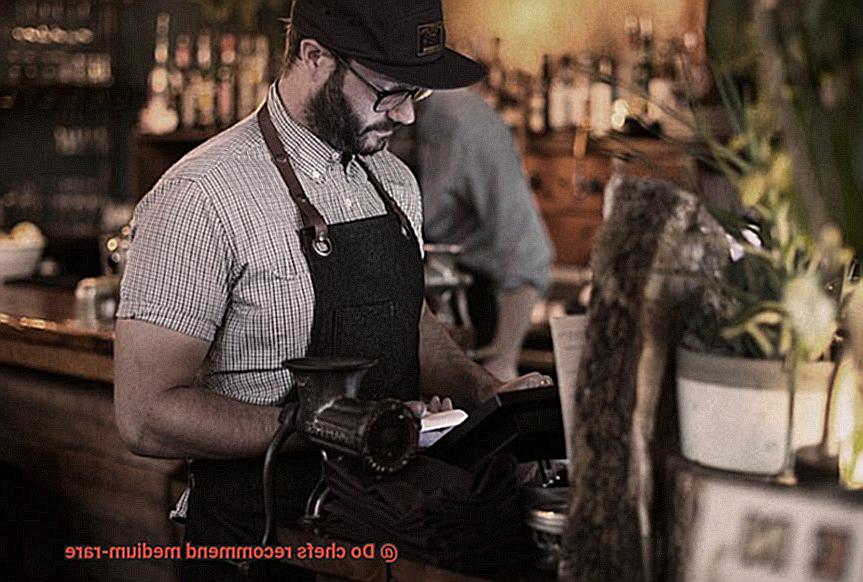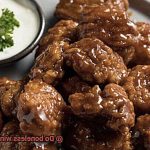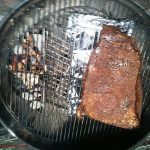Are you a steak lover who’s always on the hunt for the perfect cut? Do you find yourself stuck between ordering a rare or medium-rare steak? Don’t worry, you’re not alone. Many of us have faced this dilemma before. But what do chefs recommend as the best doneness level?
It all starts with a great cut, but the real magic happens in the cooking process. Cooking temperatures and doneness levels play a crucial role in bringing out the best flavor and texture in your steak. While some may prefer their steak well-done, chefs all over the world will tell you that medium-rare is where it’s at.
In this blog post, we’ll explore why chefs recommend medium-rare cooked steaks. We’ll dive deep into the science behind cooking a perfect steak, including ideal temperatures and factors that influence doneness levels. We’ll also address some of the common misconceptions surrounding rare and medium-rare steaks and their health implications.
So grab your knives and let’s embark on a mouth-watering journey to discover why chefs recommend medium-rare as the go-to doneness level for your next perfect steak.
Contents
What Does Medium-Rare Mean?
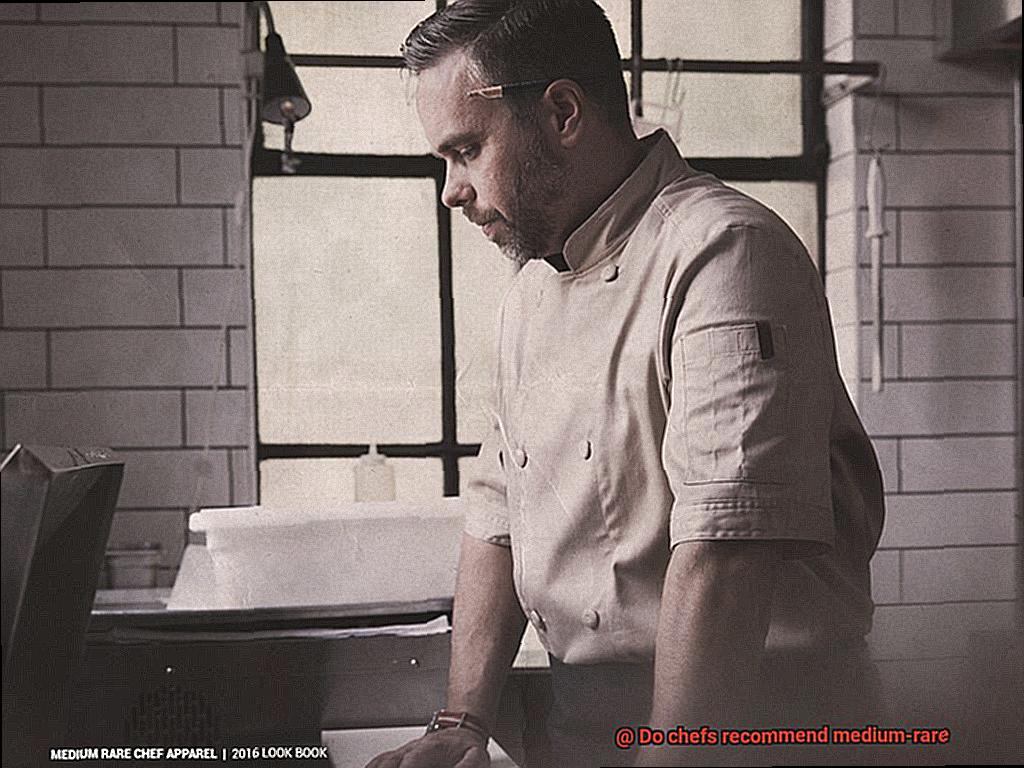
Well, in simple terms, medium-rare refers to the internal temperature and level of doneness of beef during cooking.
When beef is cooked to medium-rare, it means that the internal temperature of the meat has reached 135-145 degrees Fahrenheit. This results in a pinkish-red center with a slightly browned crust on the outside. The texture of medium-rare beef is tender and juicy, making it a popular choice for steak lovers.
Chefs often recommend cooking beef to medium-rare as it allows the meat to retain its natural juices and flavors. Overcooking can make the meat dry and tough, ruining both the texture and taste of the dish. Additionally, when meat is cooked to well-done, it becomes challenging to distinguish whether the meat is of high quality or not. However, when cooked to medium-rare, the natural flavor and texture of the meat are accentuated.
It’s essential to remember that cooking meat to medium-rare isn’t just about cooking it for a specific duration. The internal temperature is what matters most. Therefore, many chefs and home cooks use a meat thermometer to ensure that their meat is cooked perfectly.
While some people may prefer their beef cooked differently, medium-rare is generally considered the best option because it allows the meat to retain its natural juices and flavor without being undercooked or overcooked. Some cuts like ribeye, sirloin, and filet mignon are best served medium-rare.
It’s important to keep in mind that certain types of meat like pork and chicken should always be cooked well-done to avoid foodborne illnesses. Additionally, some customers may have personal preferences for how they like their meat cooked, and it’s crucial for chefs to cater to these requests.
Why Do Chefs Recommend Cooking Meat to a Medium-Rare Doneness?
Firstly, cooking meat to a medium-rare doneness ensures that the meat is cooked all the way through while retaining its juiciness and flavor. Overcooking meat can lead to a dry and tough texture that is unappetizing and difficult to chew. By cooking it to this level, you can guarantee that it will be tender, flavorsome, and enjoyable to eat.
But that’s not the only reason. Cooking meat to a medium-rare doneness also allows for the Maillard reaction to occur. This fascinating chemical reaction happens when proteins and sugars in the meat are heated together, creating a brown crust on the outside of the meat and contributing to its irresistible flavor and aroma. The result is a perfectly seared steak with a crispy exterior and a succulent interior.
Now, some people may be concerned about food safety when it comes to cooking meat. However, cooking meat to a medium-rare doneness is still considered safe as long as it reaches an internal temperature of at least 145°F (63°C). In fact, cooking meat to higher temperatures can destroy its natural flavor and texture, leaving it bland and unappetizing.
Overall, chefs recommend cooking meat to a medium-rare doneness because it strikes a balance between safety, flavor, and texture. Here are some of the reasons why:
- It retains the natural juiciness and flavor of the meat
- It allows for the Maillard reaction, which creates a delicious brown crust on the outside of the meat
- It ensures that any harmful bacteria or pathogens in the meat are killed off
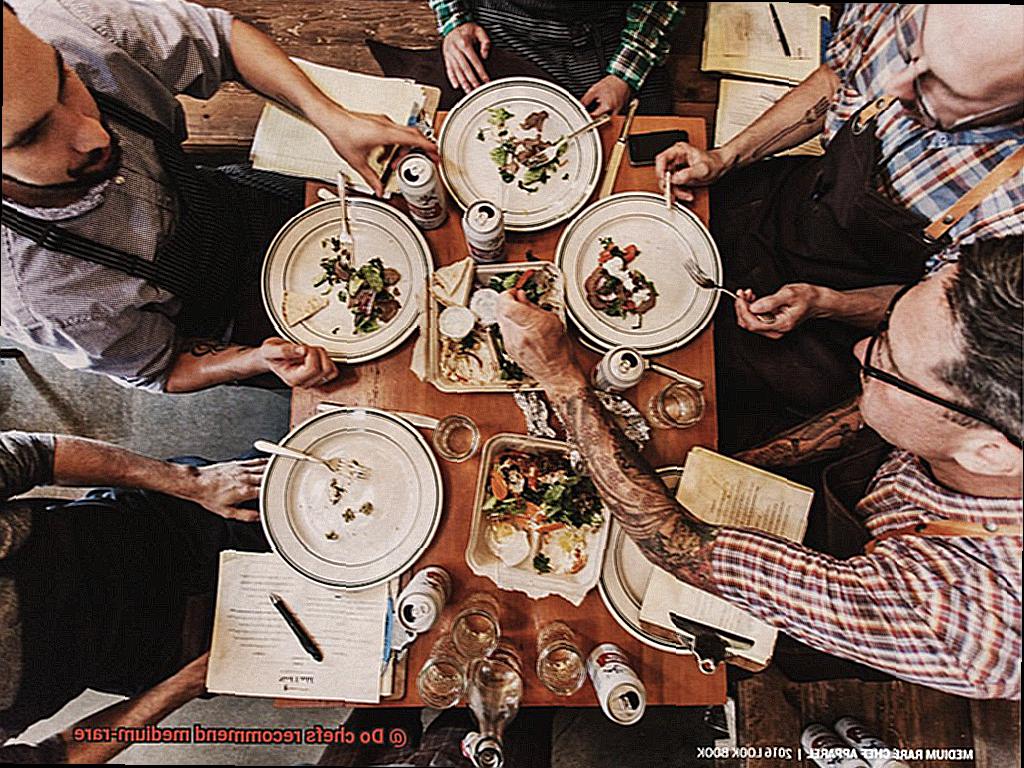
Is Medium-Rare the Best Way to Showcase the Quality of the Meat?
When it comes to cooking meat, achieving the perfect balance between flavor and texture can be a challenge. However, medium-rare cooking offers a solution to this issue, making it a popular choice among chefs.
One of the primary reasons why medium-rare is an excellent way to showcase the quality of meat is because this temperature allows the meat to be cooked through while retaining its juiciness and natural flavors. The result is a taste that is both savory and tender, providing a sensory experience that cannot be beaten.
Moreover, many chefs believe that medium-rare cooking provides the best possible texture for meat. Higher cooking temperatures can cause meat to become tough and chewy, which detracts from its overall quality. On the other hand, when cooked to medium-rare, the meat remains tender and easy to chew, making it a pleasure to eat.
Apart from flavor and texture, cooking meat to medium-rare can also have health benefits. Overcooking meat can lead to the formation of harmful compounds such as HCAs and PAHs, which are known carcinogens. Cooking meat to medium-rare reduces the formation of these compounds, making it a healthier option for those who enjoy grilled or roasted meats.
In summary, here are some key reasons why medium-rare is the best way to showcase the quality of meat:
- It provides a perfect balance between flavor and tenderness.
- It offers an excellent texture that is easy to chew.
- It reduces the formation of harmful compounds that can be found in overcooked meats.
What Types of Meat Should Not Be Cooked to Medium-Rare?
When it comes to cooking meat, the level of doneness is a matter of personal preference. However, certain types of meat should never be cooked to medium-rare. These meats contain harmful bacteria or parasites that can only be killed off by cooking them thoroughly. Let’s dive deeper into the types of meat that should not be cooked to medium-rare.
Ground Meat:
Ground beef is a popular choice for burgers, meatballs, and other dishes. However, ground meat should never be served medium-rare as it can contain bacteria such as E. coli or salmonella that can lead to serious foodborne illnesses. To ensure that ground meat is safe to eat, it should always be cooked to an internal temperature of 160°F (71°C) or above.
Poultry:

Chicken and turkey are versatile meats that can be cooked in various ways. However, poultry should never be served medium-rare as it can contain harmful bacteria like salmonella that can cause food poisoning. To eliminate any bacteria present in poultry, it should always be cooked to an internal temperature of at least 165°F (74°C).
Wild Game:
Wild game meats like venison or elk have gained popularity in recent years due to their unique flavor. However, these meats should never be cooked to medium-rare as they may carry parasites that can only be killed off by cooking the meat to a higher temperature. The recommended internal temperature for wild game is 160°F (71°C) for medium and 170°F (77°C) for well-done.
Accommodating Customer Preferences for How They Like Their Meat Cooked
While chefs are trained to prepare meats to specific temperatures, it is ultimately up to the customer to decide how they want their meat cooked. This can be a challenging task, as chefs must ensure the meat is safe to eat while also satisfying the customer’s desired level of doneness.
One of the most popular preferences among customers is medium-rare. Achieving this perfect balance requires cooking the meat enough to reach an internal temperature of 135°F (57°C) while still retaining its natural flavors and juices. However, some customers prefer their meats well-done, which can present a unique challenge for chefs. Cooking meat for too long risks drying it out and making it tough.
To overcome this challenge, chefs use various cooking techniques such as searing or braising to lock in the juices and flavor of the meat. These techniques can help ensure that even a well-done cut of meat remains succulent and delicious. Chefs may also suggest alternative cuts of meat that are better suited for well-done cooking, such as a tougher cut like chuck roast.
In addition to cooking techniques, communication is essential when accommodating customer preferences for how they like their meat cooked. Some customers may not be familiar with different cooking temperatures or may have specific requests that require clarification. Chefs must be knowledgeable about different cooking methods and temperatures and be willing to work with customers to ensure their dining experience meets their expectations.
Tips for Cooking Meat to a Medium-Rare Doneness
Cooking meat to the perfect level of doneness can be a challenge, but achieving a medium-rare level is a popular choice for many chefs and foodies. Here are five tips and techniques to help you cook meat to a delicious medium-rare:
Let the Meat Come to Room Temperature
Before cooking the meat, let it sit at room temperature for about 30 minutes. This helps ensure that the meat cooks evenly throughout, resulting in a juicy and tender final product.
Use a Meat Thermometer
A meat thermometer is essential in determining the internal temperature of the meat. For a medium-rare steak, the internal temperature should be around 130-135°F (55-57°C). Insert the thermometer into the thickest part of the meat to get an accurate reading.
Sear the Meat on High Heat
Searing the meat on high heat first helps create a flavorful crust while locking in juices, resulting in tender and juicy meat. Use a hot pan or grill to quickly sear the exterior of the meat before finishing it in the oven or on the grill.
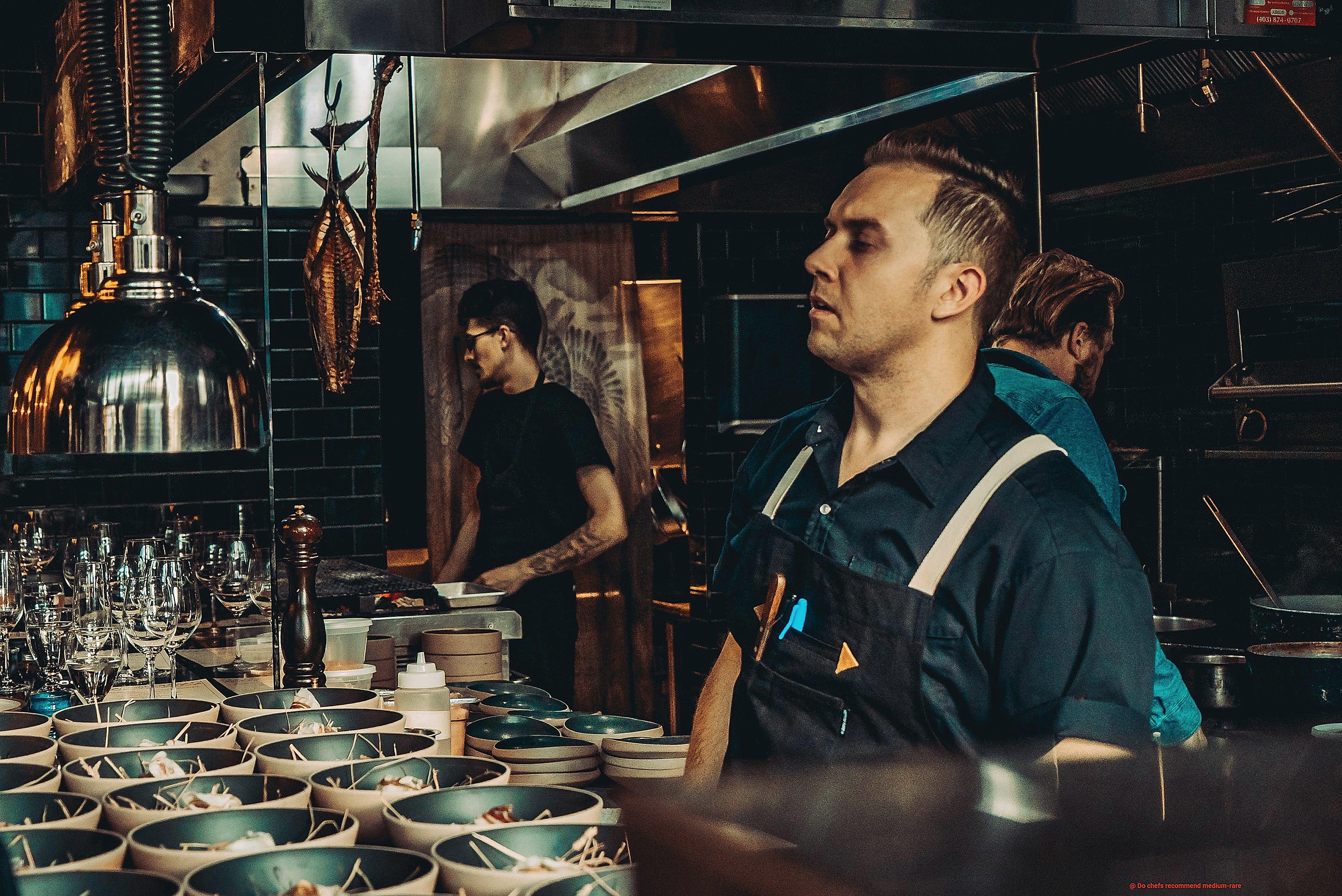
Baste with Butter, Herbs, and Garlic
While cooking the meat, basting it with butter, herbs, and garlic can add extra flavor and moisture. As the butter melts, it infuses the meat with rich flavors, resulting in a mouth-watering meal.
Let the Meat Rest
After cooking the meat, let it rest for a few minutes before slicing into it. This allows for the juices to redistribute throughout the meat, resulting in a more tender and flavorful final product. Cover the meat with foil to keep it warm while it rests.
It’s important to note that not all cuts of meat are suited for medium-rare cooking. Some cuts, such as filet mignon or ribeye, are naturally more tender and flavorful than others, making them ideal for cooking to medium-rare. However, leaner cuts like sirloin may become tough if cooked to this level of doneness and may be better suited for medium or medium-well.
Benefits of Cooking Meat to a Medium-Rare Doneness
As a meat aficionado, you’re likely familiar with the age-old debate about the perfect level of doneness. But let me tell you, cooking your meat to medium-rare is the epitome of flavor and texture. High-end restaurants often cook their steaks to medium-rare, and for good reason. Let’s dive into the benefits of cooking meat to a medium-rare doneness:
- Moisture and Tenderness – Cooking meat to well-done can result in tough, dry meat. But by cooking your meat to medium-rare, you’ll retain much of its moisture and tenderness. The high heat that comes with cooking meat to higher levels of doneness causes the muscle fibers to contract and expel their natural juices, resulting in less tender, drier meat. So why not savor a juicy, tender piece of meat by opting for medium-rare?
- Enhanced Flavor – Cooking meat at high temperatures for long periods can develop a charred or burnt taste that can ruin the natural flavors of the meat. By cooking your meat to medium-rare, you’ll avoid this problem and allow the natural flavors of the meat to shine through. This is especially true for beef cuts like ribeye or filet mignon, which are known for their rich flavor.
- Safe Temperature – Some people may be hesitant to eat meat that isn’t fully cooked, but with a thermometer, you can ensure that your meat reaches a safe temperature of 145°F (63°C) while still enjoying the benefits of medium-rare doneness.
To achieve a perfectly cooked medium-rare steak, follow these tips: let the meat come to room temperature before cooking, use a thermometer to ensure proper internal temperature, sear on high heat to create a flavorful crust, baste with butter, herbs, and garlic for added richness and depth of flavor, and let it rest before slicing.
Drawbacks of Cooking Meat to a Medium-Rare Doneness
As a self-proclaimed meat connoisseur, cooking meat to a medium-rare doneness may seem like the ultimate goal. However, as an expert in the field, I have researched and discovered some potential drawbacks that are worth considering before indulging in this popular cooking method.
First and foremost, there is the risk of bacterial contamination. The USDA recommends cooking meat to a minimum internal temperature of 145°F to destroy any harmful bacteria. Cooking meat to medium-rare temperatures increases the risk of foodborne illness, especially if proper handling and storage procedures are not followed.
In addition to safety concerns, achieving consistent results can be challenging when cooking meat to medium-rare. Depending on the thickness and cut of the meat, as well as the cooking method used, some parts may end up overcooked or undercooked. This can result in an uneven texture and taste that may not be enjoyable for everyone.
Furthermore, personal preference plays a significant role in deciding on a cooking method. Some individuals may not appreciate the taste or texture of medium-rare meat, while certain cuts may not be suitable for this level of doneness due to their toughness or fat content.
Conclusion
Chefs from all corners of the globe agree that medium-rare is the perfect doneness level for steaks. Not only does it guarantee a safe temperature, but it also retains the natural juices and flavors of the meat. The Maillard reaction, which creates a delicious brown crust on the outside of the steak, adds to its irresistible flavor and aroma. Cooking meat to medium-rare also helps reduce harmful compounds found in overcooked meats.
While some may prefer their beef cooked differently, medium-rare is generally considered the best option because it allows for optimal juiciness and flavor without being undercooked or overcooked. However, certain types of meat like ground beef, poultry, and wild game should never be served medium-rare due to potential bacterial contamination.
To achieve a perfectly cooked medium-rare steak, there are several crucial steps to follow. First, let the meat come to room temperature before cooking. Use a thermometer to ensure proper internal temperature and sear on high heat to create a flavorful crust. Basting with butter and herbs adds richness and depth of flavor while letting it rest before slicing ensures maximum juiciness.
Overall, cooking meat to medium-rare doneness strikes an excellent balance between safety, flavor, and texture. While there are potential drawbacks such as bacterial contamination and inconsistent results depending on personal preference and cut of meat used, it remains a popular choice among chefs and foodies alike.

